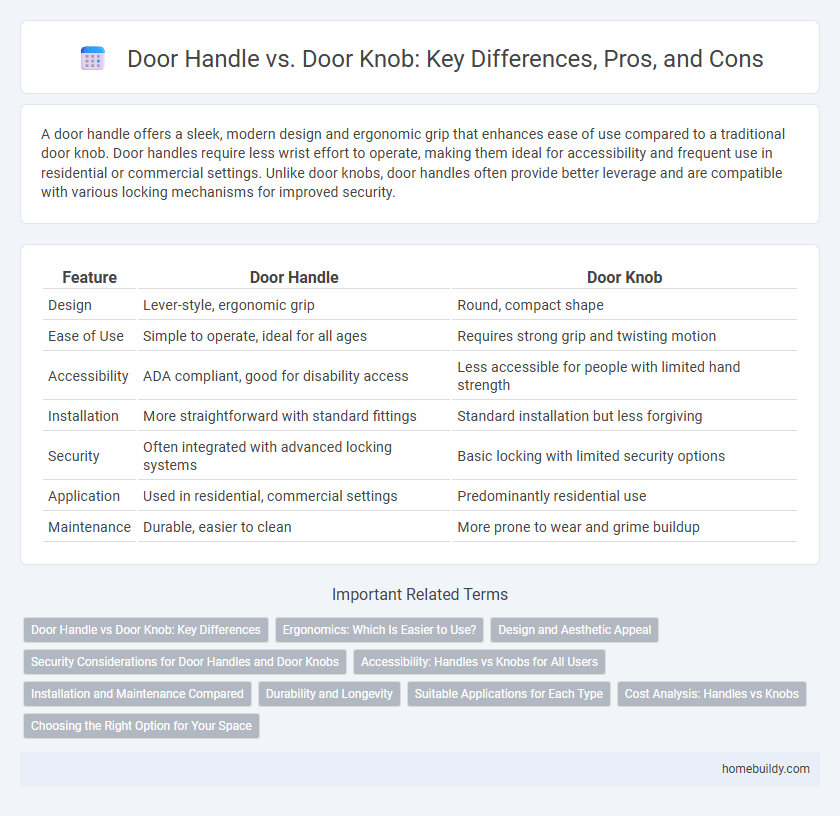A door handle offers a sleek, modern design and ergonomic grip that enhances ease of use compared to a traditional door knob. Door handles require less wrist effort to operate, making them ideal for accessibility and frequent use in residential or commercial settings. Unlike door knobs, door handles often provide better leverage and are compatible with various locking mechanisms for improved security.
Table of Comparison
| Feature | Door Handle | Door Knob |
|---|---|---|
| Design | Lever-style, ergonomic grip | Round, compact shape |
| Ease of Use | Simple to operate, ideal for all ages | Requires strong grip and twisting motion |
| Accessibility | ADA compliant, good for disability access | Less accessible for people with limited hand strength |
| Installation | More straightforward with standard fittings | Standard installation but less forgiving |
| Security | Often integrated with advanced locking systems | Basic locking with limited security options |
| Application | Used in residential, commercial settings | Predominantly residential use |
| Maintenance | Durable, easier to clean | More prone to wear and grime buildup |
Door Handle vs Door Knob: Key Differences
A door handle offers a lever-style mechanism that provides easier grip and accessibility compared to a traditional door knob, which requires a twisting motion. Door handles are often favored for ergonomic benefits and compliance with ADA (Americans with Disabilities Act) standards, making them suitable for both residential and commercial use. In contrast, door knobs tend to be more compact and aesthetically varied, but can pose challenges for users with limited hand strength or dexterity.
Ergonomics: Which Is Easier to Use?
Door handles offer better ergonomics than door knobs, as their lever design requires less grip strength and wrist rotation, making them easier to operate for people with arthritis or limited hand mobility. Door knobs demand a full grasp and twisting motion, which can be cumbersome and uncomfortable, especially for children and the elderly. Lever-style door handles enhance accessibility by allowing use with an elbow or forearm when hands are full, improving overall ease of use.
Design and Aesthetic Appeal
Door handles offer a sleek and modern design, often featuring elongated shapes and minimalist lines that complement contemporary interiors. Door knobs typically showcase a more traditional and rounded form, providing a classic and timeless aesthetic. The choice between a door handle and a door knob significantly impacts the overall style and visual appeal of a door, with handles favored for modern elegance and knobs for vintage charm.
Security Considerations for Door Handles and Door Knobs
Door handles typically offer enhanced security features compared to door knobs, as they often incorporate more robust locking mechanisms and are less susceptible to forced entry. Door handles are generally easier to engage with locking systems such as deadbolts or electronic locks, improving overall door security. In contrast, door knobs can be easier to manipulate or break, making them a less secure choice for high-security areas.
Accessibility: Handles vs Knobs for All Users
Door handles offer superior accessibility compared to door knobs, especially for individuals with limited hand strength or dexterity, as they require less grip and twisting motion. Lever-style handles comply better with the Americans with Disabilities Act (ADA) guidelines, facilitating easier operation for children, elderly, and people with disabilities. Door knobs, on the other hand, can pose challenges due to their round shape and need for firm grasping, making handles the preferred choice in accessible design.
Installation and Maintenance Compared
Door handles generally offer easier installation than door knobs, often requiring only a screwdriver and standard fittings, whereas door knobs can involve more complex mechanisms and alignment challenges. Maintenance for door handles is typically simpler due to fewer moving parts and a more streamlined design, reducing the likelihood of wear and tear. Door knobs may require more frequent lubrication and adjustments to ensure smooth operation, increasing overall upkeep compared to door handles.
Durability and Longevity
Door handles typically offer greater durability and longevity compared to door knobs due to their solid construction and fewer moving parts, reducing wear and tear over time. High-quality materials such as stainless steel or brass used in door handles enhance resistance to corrosion and mechanical damage. This makes door handles a preferred choice in high-traffic areas where long-term reliability is critical.
Suitable Applications for Each Type
Door handles are ideal for commercial buildings and modern interiors where ease of use and accessibility are essential, often preferred in spaces requiring ADA compliance due to their lever mechanism. Door knobs suit residential settings where aesthetic appeal and traditional styling are prioritized, making them common in bedrooms and closets that do not demand heavy-duty use. The choice between door handle and door knob depends on application-specific factors such as user accessibility, frequency of use, and design preferences.
Cost Analysis: Handles vs Knobs
Door handles typically cost more than door knobs due to their complex design and additional materials, with average prices ranging from $20 to $150 compared to knobs' $10 to $50. Installation costs can also be higher for handles, often requiring professional help, which adds to the overall expense. Despite the higher upfront cost, door handles offer ergonomic benefits and durability, potentially reducing replacement frequency and long-term costs.
Choosing the Right Option for Your Space
Door handles offer a sleek, modern look and ergonomic grip, making them ideal for contemporary spaces, while door knobs provide a classic aesthetic with a compact design suited for traditional interiors. When choosing the right option for your door, consider factors such as ease of use, security features, and compatibility with existing hardware. Lever-style handles typically provide better accessibility for individuals with limited hand mobility compared to round knobs.
Door handle vs Door knob Infographic

 homebuildy.com
homebuildy.com